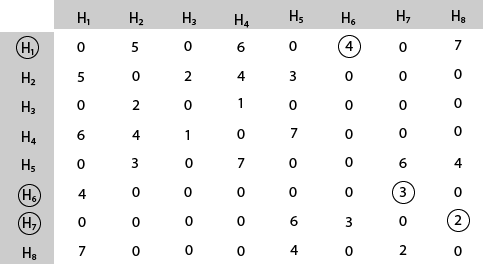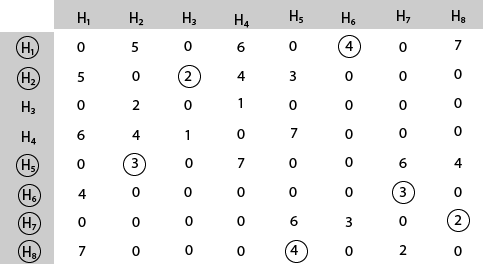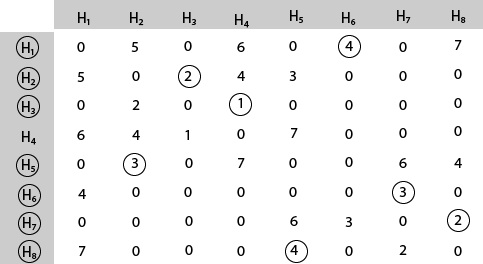Travelling Sales Person ProblemThe traveling salesman problems abide by a salesman and a set of cities. The salesman has to visit every one of the cities starting from a certain one (e.g., the hometown) and to return to the same city. The challenge of the problem is that the traveling salesman needs to minimize the total length of the trip. Suppose the cities are x1 x2..... xn where cost cij denotes the cost of travelling from city xi to xj. The travelling salesperson problem is to find a route starting and ending at x1 that will take in all cities with the minimum cost. Example: A newspaper agent daily drops the newspaper to the area assigned in such a manner that he has to cover all the houses in the respective area with minimum travel cost. Compute the minimum travel cost. The area assigned to the agent where he has to drop the newspaper is shown in fig: 
Solution: The cost- adjacency matrix of graph G is as follows: costij = 
The tour starts from area H1 and then select the minimum cost area reachable from H1. 
Mark area H6 because it is the minimum cost area reachable from H1 and then select minimum cost area reachable from H6. 
Mark area H7 because it is the minimum cost area reachable from H6 and then select minimum cost area reachable from H7. 
Mark area H8 because it is the minimum cost area reachable from H8. 
Mark area H5 because it is the minimum cost area reachable from H5. 
Mark area H2 because it is the minimum cost area reachable from H2. 
Mark area H3 because it is the minimum cost area reachable from H3. 
Mark area H4 and then select the minimum cost area reachable from H4 it is H1.So, using the greedy strategy, we get the following. 4 3 2 4 3 2 1 6 H1 → H6 → H7 → H8 → H5 → H2 → H3 → H4 → H1. Thus the minimum travel cost = 4 + 3 + 2 + 4 + 3 + 2 + 1 + 6 = 25 Matroids:A matroid is an ordered pair M(S, I) satisfying the following conditions:
We say that a matroid M (S, I) is weighted if there is an associated weight function w that assigns a strictly positive weight w (x) to each element x ∈ S. The weight function w extends to a subset of S by summation: w (A) = ∑x∈A w(x) for any A ∈ S.
Next TopicDynamic Programming vs Greedy Method
|
 For Videos Join Our Youtube Channel: Join Now
For Videos Join Our Youtube Channel: Join Now
Feedback
- Send your Feedback to [email protected]
Help Others, Please Share










